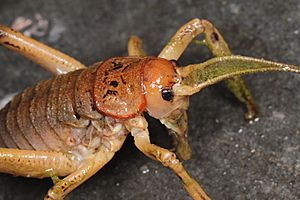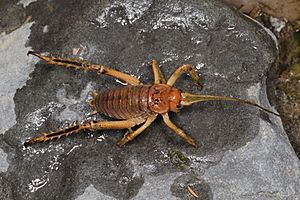Deinacrida parva facts for kids
Quick facts for kids Deinacrida parva |
|
|---|---|
 |
|
| Conservation status | |
| Scientific classification | |
| Genus: |
Deinacrida
|
| Species: |
parva
|
The Kaikoura wētā (Deinacrida parva) is a special insect from New Zealand. It belongs to a group called Anostostomatidae, which includes king crickets and wētā. This wētā is also known as the Kaikoura giant wētā. It was first found in 1894 and then seen again in 1966. You can only find it in the northern part of New Zealand's South Island. It's a small to medium-sized wētā.
Contents
What is the Kaikoura Wētā Like?

The Kaikoura wētā has a round, brown body. Female wētā are bigger than males. But males have long legs, which might help them compete for mates. Females have a long spike at the end of their body. This spike is called an ovipositor, and they use it to lay eggs in the soil.
This wētā can grow up to about 100mm long. It can weigh up to 14.5 grams. They usually live for about two years. The Kaikoura wētā looks a lot like another wētā, Deinacrida rugosa. But the Kaikoura wētā is smaller and has darker brown coloring under its belly. Sometimes, it also has red or pink on its chest shield. A good way to tell it apart is to count the six spines on its lower back leg.
Where Does the Kaikoura Wētā Live?
Kaikoura wētā live in many different land environments. They are often found under large logs on river flats. They also like scrub areas near the edges of forests. Many of them live under Matai logs. Sometimes, they can drown because they live so close to water. This might also be linked to tiny worms inside them.
You can find D. parva between 150 and 1500 meters above sea level. They live from South Marlborough to Hanmer Springs. These wētā are experts at living in subalpine areas. They are most common near the Hapuku and Kowhai rivers. These rivers are close to Kaikōura, which is how they got their name. Scientists think they now live in less than 10% of the places they used to.
What Does the Kaikoura Wētā Eat?
The Kaikoura wētā is a herbivore. This means it eats plants. They mainly feed on the leaves of trees and shrubs. Female wētā sometimes eat dead or dying insects. They do this to get extra protein. This protein helps them make eggs during breeding season.
How Does the Kaikoura Wētā Behave?
Like many other wētā in New Zealand, the Kaikoura wētā is nocturnal. This means it is active at night.
D. parva can make sounds. They do this by rubbing spines on their back plates together. They also use tiny hairs called sensilla. These sounds are usually made when they pull in their belly. They often make sounds at the same time as a defensive leg kick. This is like a warning to others. The sounds they make are soft hisses. They are often too high-pitched for humans to hear.
Making sounds with hair sensilla is rare for insects. One idea why this wētā does it is to protect itself. It might be a defense against the short-tailed bat in New Zealand. We don't know if they use these sounds to talk to each other. More research is needed to find out.
How Do Kaikoura Wētā Reproduce?
Scientists have tried to breed D. parva in captivity. It was hard to set up breeding pairs. This is because the wētā were caught at different ages. Young wētā can grow up and become ready to breed in captivity. But some females do not lay eggs. Females lay their eggs in the soil using their ovipositor.
Why is the Kaikoura Wētā Important to Protect?
In some areas, the number of Kaikoura wētā has dropped to just a few. Many wētā have died in the large groups near Kaikoura. Even with these deaths, the overall population is thought to be stable.
A big reason for their decline is likely habitat loss. Their homes are being cleared. Also, pests that eat them are a problem. Changes to their natural habitat make it harder for smaller groups to survive. Many of their original homes have been turned into farmland. Some deaths might be linked to a tiny worm called the Gordian worm parasite. But we don't know the full effect of this parasite yet. Wētā that have this parasite have fewer babies.
More surveys are needed to find out how many wētā there are. We also need to know exactly where they live. This has been hard because there are not many wētā. Also, the places they live have thick plants and uneven ground. Searching for them in fallen logs can also damage their homes.
Scientists have suggested breeding them in safe places. Then, they could be released onto islands without predators. Managing their habitat on the mainland has also been suggested. This would help protect them.


